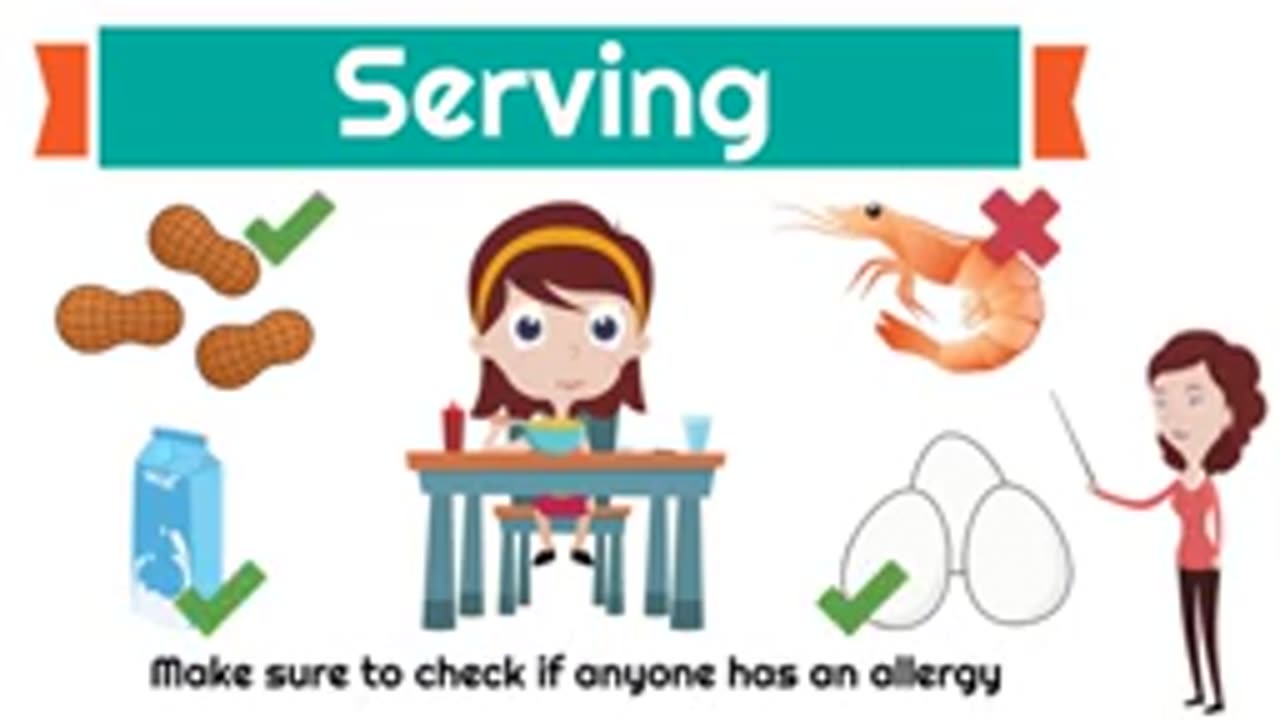Premium Only Content

Serving Food
### **Serving Food Safely: Essential Tips for a Safe Meal**
Serving food properly is just as important as preparing and cooking it. To ensure that food is safe for consumption and to prevent the spread of foodborne illnesses, here are some essential tips for serving food safely:
---
### **1. Maintain Proper Temperature**
- **Why**: Bacteria multiply quickly at temperatures between 5°C and 60°C (41°F to 140°F). Keeping food at the right temperature prevents harmful microorganisms from growing.
- **How**:
- **Hot foods** should be kept at **above 60°C (140°F)** to maintain safety. Use chafing dishes, slow cookers, or warming trays to keep food hot.
- **Cold foods** should be served at **below 5°C (41°F)**. Use coolers or ice packs to keep salads, meats, and other chilled items cold.
- **Use a thermometer** to check the temperature of foods both when cooking and when serving to ensure they remain at safe temperatures.
---
### **2. Avoid Cross-Contamination**
- **Why**: Cross-contamination occurs when harmful bacteria from raw foods or surfaces are transferred to cooked or ready-to-eat foods.
- **How**:
- **Use clean utensils** when serving food, and avoid using the same utensils for raw and cooked items.
- **Serve food in clean dishes** and ensure serving containers are sanitized.
- **Store ready-to-eat foods** away from raw items during preparation and serving.
---
### **3. Practice Good Personal Hygiene**
- **Why**: Food handlers’ hygiene is essential in preventing the spread of bacteria and viruses that cause foodborne illnesses.
- **How**:
- **Wash hands** thoroughly before serving food and after touching raw foods, using the restroom, or touching your face.
- **Wear gloves** or use utensils when serving ready-to-eat foods to minimize direct contact with hands.
- **Maintain clean clothing** and use aprons or uniforms to prevent contamination.
---
### **4. Use Clean Serving Dishes and Utensils**
- **Why**: Serving food in clean dishes and using sanitized utensils helps ensure food is not contaminated during service.
- **How**:
- **Ensure serving trays, plates, and utensils** are cleaned and sanitized before each use.
- **Avoid reusing plates or utensils** that have been in contact with raw food without cleaning them first.
- **Cover food** when transporting it to protect it from airborne contaminants.
---
### **5. Serve Immediately or Store Properly**
- **Why**: Keeping food at room temperature for too long can promote bacterial growth, leading to potential foodborne illnesses.
- **How**:
- **Serve food promptly** after cooking to minimize the time it sits in the temperature danger zone.
- If food cannot be served immediately, **hold it at a safe temperature** (either hot or cold) using proper equipment.
- **Store leftovers** within two hours of serving (or one hour if the temperature is above 32°C/90°F), and refrigerate or freeze them in sealed containers.
---
### **6. Ensure Safe Food Handling for Allergens**
- **Why**: Cross-contact with allergens can be harmful, especially for individuals with food allergies.
- **How**:
- **Clearly label foods** that contain common allergens such as nuts, dairy, eggs, or shellfish.
- **Serve allergen-free food separately** from foods that contain allergens to prevent cross-contact.
- **Train staff** to handle and serve allergen-free foods with caution to avoid any accidental mixing.
---
### **7. Monitor Portion Sizes**
- **Why**: Proper portion control helps in maintaining food safety and minimizes food waste.
- **How**:
- **Use portioning tools** such as ladles, spoons, or tongs to ensure consistent serving sizes.
- Avoid overloading plates or serving dishes with too much food, which can lead to uneven temperatures and potential contamination.
---
### **8. Use Proper Serving Techniques for Special Food Types**
- **Why**: Some food types require special handling due to their temperature sensitivity or nature.
- **How**:
- **Buffet-style service**: Keep foods covered and on ice or heated trays to maintain proper temperature.
- **Family-style service**: Ensure serving dishes and utensils are sanitized, and consider using individual plates to minimize contact with shared dishes.
- **Prepackaged meals**: Ensure packaging is intact and food has been stored at the correct temperature.
---
### **9. Educate and Train Food Handlers**
- **Why**: Ongoing education ensures that food handlers understand the importance of safe food handling practices during service.
- **How**:
- Regularly train all staff involved in food service on food safety procedures.
- Conduct refresher courses on proper hand hygiene, temperature control, and allergen awareness.
---
By following these guidelines for serving food safely, you can significantly reduce the risk of contamination and ensure that your meals are safe, fresh, and enjoyable. Whether you're serving food at home, in a restaurant, or at an event, these practices will help protect the health of everyone involved.
Would you like a checklist or a step-by-step guide for serving food safely at your establishment?
-
![Shadows Of Chroma Tower, Alpha Playtest [Part 1]](https://1a-1791.com/video/fwe2/1d/s8/1/5/Q/U/n/5QUnx.0kob-small-Shadows-Of-Chroma-Tower-Alp.jpg) 13:29:21
13:29:21
iViperKing
14 hours agoShadows Of Chroma Tower, Alpha Playtest [Part 1]
88.9K3 -
 54:05
54:05
TheGetCanceledPodcast
12 hours ago $11.54 earnedThe GCP Ep.11 | Smack White Talks Smack DVD Vs WorldStar, Battle Rap, Universal Hood Pass & More...
100K18 -
 13:37
13:37
Exploring With Nug
16 hours ago $6.78 earnedSUV Found Underwater Searching For Missing Man Jerry Wilkins!
67K4 -
 2:58:21
2:58:21
xBuRnTx
11 hours ago1st Warzone Stream Online
48.9K2 -
 6:10:21
6:10:21
JdaDelete
1 day ago $12.44 earnedDino Crisis - Sega Saturday
106K4 -
 23:22
23:22
MYLUNCHBREAK CHANNEL PAGE
1 day agoUnder The Necropolis - Pt 5
91.5K52 -
 2:26:11
2:26:11
Jewels Jones Live ®
2 days agoWINNING BIGLY | A Political Rendezvous - Ep. 108
150K45 -
 2:04:49
2:04:49
Bare Knuckle Fighting Championship
4 days agoBKFC FIGHT NIGHT MOHEGAN SUN FREE FIGHTS
77K7 -
 25:09
25:09
BlackDiamondGunsandGear
14 hours agoYou NEED to be Training For Whats to Come
53.1K11 -
 20:03
20:03
Sideserf Cake Studio
19 hours ago $1.85 earnedA HUNGRY HUNGRY HIPPOS CAKE THAT ACTUALLY WORKS?
49.4K14